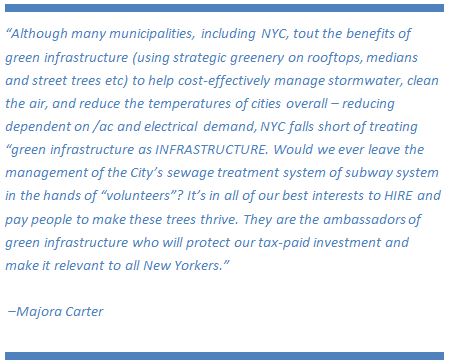Treating Trees as Actual Infrastructure
A couple of weeks ago my brother sent me a link to a story on WNYC about the variable mortality rates for trees that were planted as part of New York City's Million Trees initiative. We've seen the uneven outcomes of planting efforts like these before, and New York is no exception. Dedicated (volunteer) citizens who water and care for the trees are often the ones responsible for their survival, particularly during harsh summer months.
The reporter, Matthew Schuerman, found that Parks Department data from 2009 indicated a 3.4 percent mortality rate for the trees, which would be well within the expected range. According to WNYC's analysis of more recent data from 2011 (obtained through a Freedom of Information Request), however, the mortality rate is as high as 12.1 percent.
I'm all too familiar with stories like this, and I scrolled to the bottom to see what commenters had to say. One stuck out at me:
This was written by Majora Carter, an urban revitalization strategy consultant who established Sustainable South Bronx and Green for All, and she had a point. A great point. What would it mean to treat trees and soils, known as green infrastructure here and elsewhere, as actual infrastructure? It certainly wouldn't, for example, mean leaving planning in the hands of people without any training in urban forestry or tree biology, or leaving their care entirely up to volunteers or homeowners. As Carter points out, imagine if that was our approach to planning and maintaining other forms of infrastructure, such as pipes and sewers?
I asked three people with tons of experience in trees and in urban forestry – who are also frequent contributors to this blog – to pick just five things that would be necessary if we actually treated urban trees and soils (green infrastructure) as seriously as we do pipes, sewers, roads, and more (grey infrastructure). What would they be this brave (and amazing!) new world would look like? Here's how they answered:
Ellyn Shea, ISA, garden educator
"Certified arborists involved throughout the planning and construction"
1. Required input by trained arborists in planning and design phases for developments.
2. Required presence by trained arborists throughout development projects with a process for shutting down the job if trees are not being preserved as specified in the preservation plan.
3. Dedicated budget funds for tree establishment/care/replacement/monitoring.
4. Specifications for nursery stock and installation; inspection by trained arborists and fines or replacement requirements if inferior materials (trees) or techniques are used. (Not dissimilar from building codes or engineering specifications)
5. Permits required for property owners to prune trees in public right of way, and properly qualified arborists must do the work according to professional pruning standards written into the municipal code.
L. Peter MacDonagh, FASLA, ISA
"Fewer trees well planted and maintained"
1. Loam soil volume minimums for street trees.
2. Nursery stock quality control (clearly visible trunk flare, single central Leader, firmly attached to root package, free of disease and pests.
3. Paid watering and monitoring for first 5 (five) years of establishment and/or available passive irrigation throughout life of the tree
4. Trunk protection from bike locks, snow plows, and vehicles
5. Pruning through life of tree.
James Urban, FASLA
"Better training and qualifications for designers"
1. Loam soil volume minimums for street trees.
2. Requirement to do assessments of existing soil (similar to what a structural engineer does for a foundation design) that we train people how to do. Not sure this is the job for an agricultural soil scientist.
3. Quality nursery stock standards, e.g., street tree, Class A commercial, Class B retail, reject,e etc.
4. Better training and qualifications for designers of tree infrastructure
5. Construction and maintenance budgets that reflect the needs and the value of the infrastructure.
This is a thought exercise only. I know most of these items will remain ideals rather than realities, possibly for a long time (maybe forever – but I hope not). The point I'm trying to explore is just how far there is to go in terms of taking trees and soils seriously as a form of urban infrastructure. Do these imaginings sound crazy to you? They shouldn't. This is the start of what truly treating trees and soils as part of our urban infrastructure could look like.
You can listen to the original WNYC story here:
Roman Kruglov / CC BY 2.0
Photo Credit: Trees as Infrastructure/shutterstock


